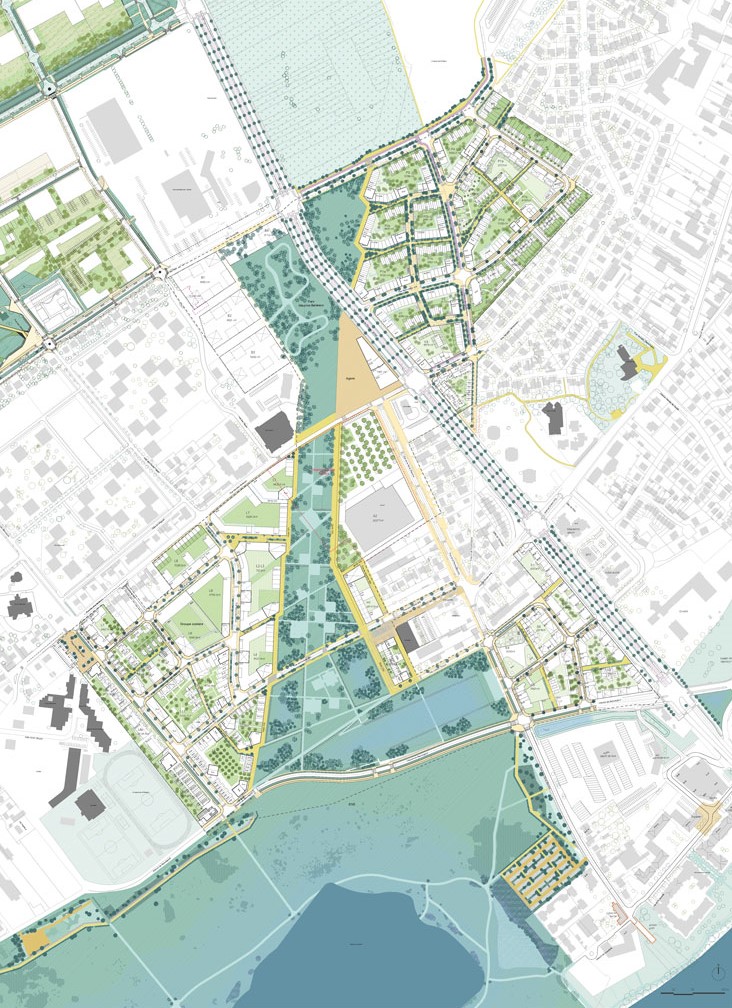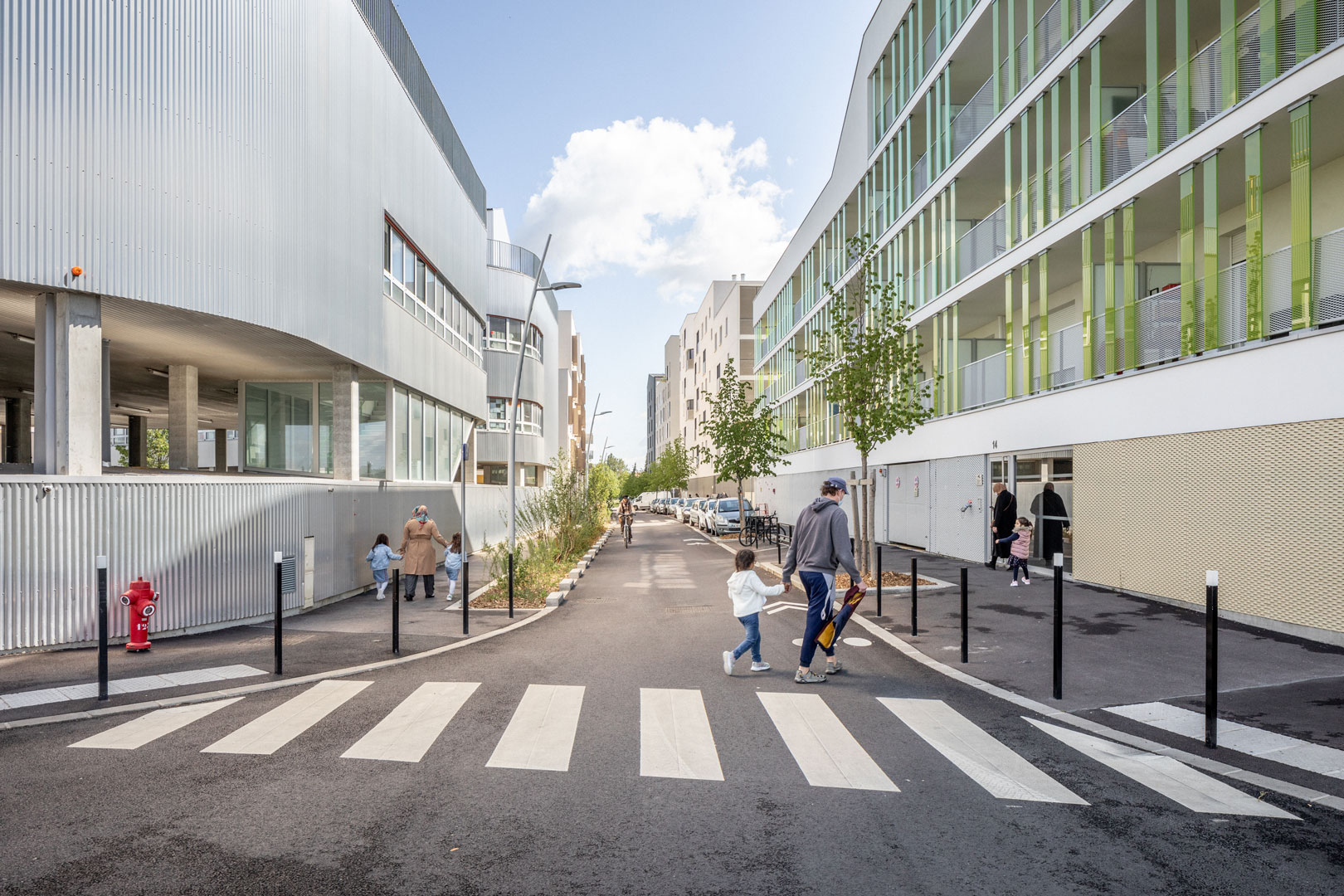
long-term support
In 2008, the town of Carrières-sous-Poissy, the Etablissement Public d’Aménagement du Mantois Seine-Aval (EPAMSA) and the Communauté d’agglomération des Deux Rives de Seine (CA2RS) launched a study on the development of a 47-hectare area located between downtown Carrières-sous-Poissy and the Saint-Louis district.
The group chose ANMA in 2009 for a 12-year mission to define the development guide plan for this joint development area, now called “Nouvelle Centralité”.
In May 2021, ANMA is renewed by EPAMSA for a new 12-year framework agreement.
The continued transformation of this area will thus be based on the workshop method set up between the urban planner, the developer and the City of Carrières-sous-Poissy.

Reintroducing nature
in the heart of the city
The town of Carrières-sous-Poissy is located in the heart of a loop of the Seine, with its ancient history of market gardening and its more recent history of sand and gravel extraction, which has greatly transformed the soil and the landscape. To this transformation is added a development of the city cut in two, linked to the will of the State to build a highway in its center.
From this history was born the project of the joint development area Nouvelle Centralité. The ban on building on the long stretch of land linking the Chanteloup plain to the Seine has been transformed into an opportunity to reinstate nature in the city. The abandoned highway project has allowed the control of land in the heart of the city and the development of a large ecological corridor.

FAIRE LA COUTURE
of two city sides
From its inception, this large green corridor structures the project, articulates and connects the two parts of the city: the downtown area to the east and the Saint-Louis district to the west. This landscape link connects the steep and wooded slopes of the Hautil massif to the banks of the Seine: it creates a vegetated gradation between the wetlands of the banks, the former sand quarries and the former market gardening plain of Chanteloup.
This new urban and central park is also a contextual solution to the frequent flooding of the Seine and the management of the city’s stormwater.
Like all the public spaces of the joint development area, it is designed to ensure the natural flow of rainwater towards the Seine. A set of paths, valleys and landscaped retention basins are articulated and based on the topography of the site to find the natural path of the water at the origin of this wet landscape, and to allow the regeneration of the soils and the native environments.

linking
to existing buildings
In an urban seam with the bangs of the existing suburban fabric, each of the newly formed neighborhoods – Beauregard, Parc, Pissefontaine, Agora and Fleurs – spreads out towards the new park and the plain and weaves links with them through their networks of streets and pedestrian paths. These, in the direction of the park, frame views towards the great landscape of the hillsides of the Seine and bring nature into the heart of this new piece of the city.
Density, urban forms and architecture are thought out in articulation with the existing urban fabric: between suburban housing, social housing and small collective housing. Thus, the new city takes the codes of the established city and develops a contemporary style and a new quality of living.
Thus, the buildings of the same block, linked by a principle of semi-detachment, reinterpret the domestic architecture of the townhouse and ensure a certain density through the creation of a new major urban façade on the park.

renewa city’s identity
The Parc du Peuple de l’Herbe, designed by the TER agency and on which the Beauregard and Parc neighborhoods are based, marks the first step in the realization of the great green corridor. The second stage is now underway with the upcoming start of the Nelson Mendela Park project, for which Ilex is the project manager. The new lots opening onto the park and the large public spaces that border it will be among the first pieces of this new urban façade. It will alternate built emergences towards the great landscape, townhouses affirming the domestic scale and large vegetal penetrations of the park towards the hearts of the blocks.
The project is worked on in an open and collaborative manner, in workshops with the city, the developer and the urban planner. It allows the creation of a common culture and a working group to build the project with the inhabitants, the promoters, the project owners and the architectural designers.

PROJECT TEAM
PROJECT MANAGEMENT
Urban planner: ANMA
Infrastructure, hydro: Infraservices
Programming: ARP
Sustainable development: Altostep
Lighting design: Icon
PRE-OPERATIONAL
Gwendoline Hamet
Thomas Hermann
Sophie Morgenthaler
Lise Martinoni,
Myriam Desbruyères
OPERATIONAL
Agrippa Leenhardt
Sébastien Moinet
Axel Chifflet

TECHNICAL SHEET
STATUS Under construction
COMMISSIONED BY
EPAMSA
Ville de Carrières-sous-Poissy
Communauté d’Agglomération des 2 Rives de la Seine
SCHEDULE 2009-2033
SURFACES 48 ha, 360 000 m² SP
WORK VALUE 36,1 M€ HT
VISUALIZATIONS Blue Print, Charles Wallon
PHOTOGRAPHY 11h45
SEE MORE
Dijon, Grand Est eco-district
Montpellier, Marianne République
Villeurbanne, Gratte-Ciel Nord
